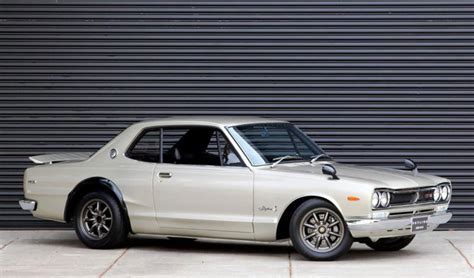
The Legendary 1972 Skyline: A Retrospective and Comprehensive Guide for Prospective Buyers
Introduction: A Journey Through Time
The year 1972 marked a pivotal moment in automotive history, witnessing the birth of a legendary Japanese sports car that would leave an indelible mark on the global automotive landscape: the Nissan Skyline. This iconic vehicle, known for its sleek design, exhilarating performance, and innovative engineering, has captivated car enthusiasts for decades, earning a reputation as a symbol of Japanese automotive prowess. In this comprehensive guide, we delve into the history, key features, and significance of the 1972 Skyline, providing prospective buyers with an in-depth understanding of this extraordinary automobile.The Skyline Legacy: A Heritage of Performance and Style
The Skyline nameplate has a rich and storied history, dating back to the 1950s. Initially introduced as a mid-sized sedan, the Skyline quickly gained recognition for its sporty character and exceptional performance. Over the years, the Skyline evolved into a symbol of Japanese automotive engineering excellence, particularly with the introduction of the Skyline GT-R in 1969. The GT-R, with its powerful engine, advanced suspension, and aggressive styling, became a formidable force on both the road and the racetrack, cementing the Skyline's reputation as a true sports car icon.The 1972 Skyline: A Game-Changer in Automotive Design
The 1972 Skyline represented a radical departure from its predecessors, introducing a revolutionary design language that would shape the future of Japanese sports cars. Its sleek, aerodynamic profile, characterized by a long hood, fastback roofline, and distinctive grille, exuded a sense of speed and agility. The car's muscular fenders, flared wheel arches, and aggressive stance further emphasized its sporty intentions. The 1972 Skyline's design not only turned heads but also set a new standard for automotive aesthetics, influencing the design of countless sports cars that followed.Unleashing Power: The Heart of the 1972 Skyline
At the heart of the 1972 Skyline lay a potent 2.0-liter inline-6 engine, designated as the S20. This technologically advanced powerplant featured a hemispherical combustion chamber design, cross-flow cylinder head, and dual overhead camshafts. With its high-revving nature and exceptional responsiveness, the S20 engine produced an impressive 160 horsepower, propelling the Skyline from 0 to 60 mph in just 8.5 seconds. The S20's distinctive exhaust note, often described as a "wail," further enhanced the car's exhilarating driving experience.Mastering the Road: Handling and Suspension
The 1972 Skyline's exceptional handling and suspension were instrumental in its reputation as a true driver's car. Its independent front and rear suspension, featuring MacPherson struts and coil springs, provided precise control and agility. The car's 50/50 weight distribution and well-balanced chassis contributed to its nimble and responsive handling, allowing drivers to navigate corners with confidence. The Skyline's power-assisted steering offered precise feedback, further enhancing the driver's connection with the road.Inside the Cockpit: Comfort and Control
The 1972 Skyline's interior was designed with both comfort and control in mind. The spacious cabin featured supportive bucket seats, a leather-wrapped steering wheel, and a comprehensive instrument cluster that provided drivers with essential information at a glance. The center console housed an array of controls, including the gearshift lever, climate control, and audio system. Despite its focus on performance, the Skyline offered a surprisingly comfortable ride, making it a practical choice for everyday use.Legacy and Impact: The Skyline's Enduring Influence
The 1972 Skyline left an indelible mark on the automotive world, solidifying the Skyline nameplate's status as a symbol of Japanese sports car excellence. Its innovative design, exhilarating performance, and exceptional handling made it a favorite among driving enthusiasts and helped elevate the Skyline to its iconic status. The 1972 Skyline's influence can still be seen in modern sports cars, demonstrating its enduring legacy as a benchmark for automotive excellence.A Collector's Dream: Owning a Piece of Automotive History
Today, the 1972 Skyline has become a highly sought-after collector's item, prized for its historical significance, rarity, and exceptional driving experience. Owning a 1972 Skyline offers a unique opportunity to connect with automotive history and experience the thrill of driving a true sports car icon. However, prospective buyers should be prepared to pay a premium for this rare and desirable vehicle.Finding the Right 1972 Skyline: A Buyer's Guide
Finding a well-maintained and original 1972 Skyline can be a challenging but rewarding endeavor. Prospective buyers should thoroughly research the market, consult with experts, and carefully inspect potential purchases. Factors to consider include the car's overall condition, mileage, service history, and any modifications or restorations that have been performed. Patience is key in finding the right 1972 Skyline, but the effort is well worth it for those seeking a piece of automotive history.Preserving the Legacy: Maintenance and Care
Owning a 1972 Skyline requires a commitment to proper maintenance and care to preserve its value and ensure its longevity. Regular servicing, including oil changes, fluid checks, and brake inspections, is essential. Parts availability can be a challenge, so it is crucial to locate reputable suppliers and mechanics who specialize in classic Japanese cars. By following a comprehensive maintenance plan, owners can keep their 1972 Skylines in pristine condition and ensure that this automotive icon continues to turn heads for generations to come.